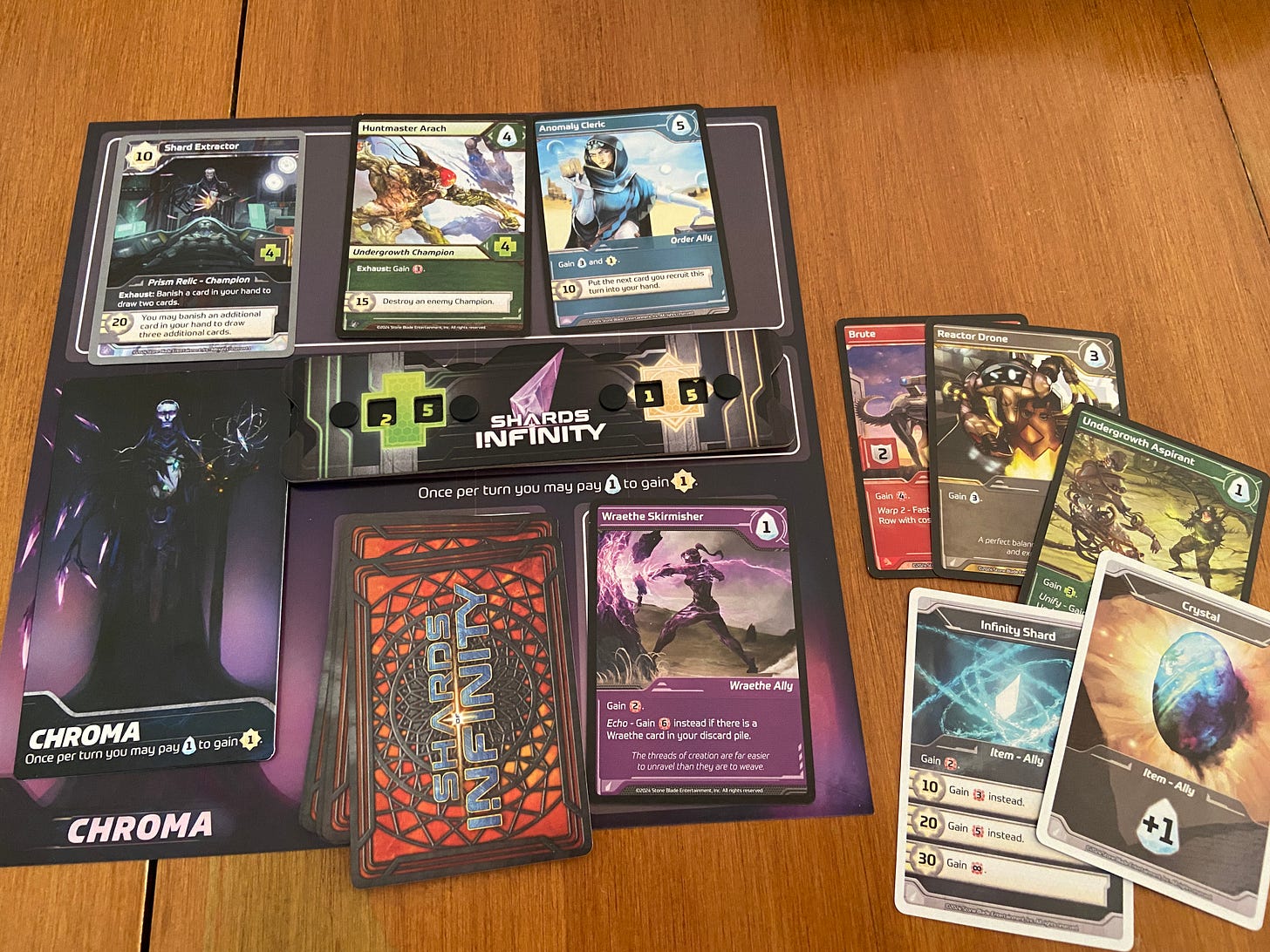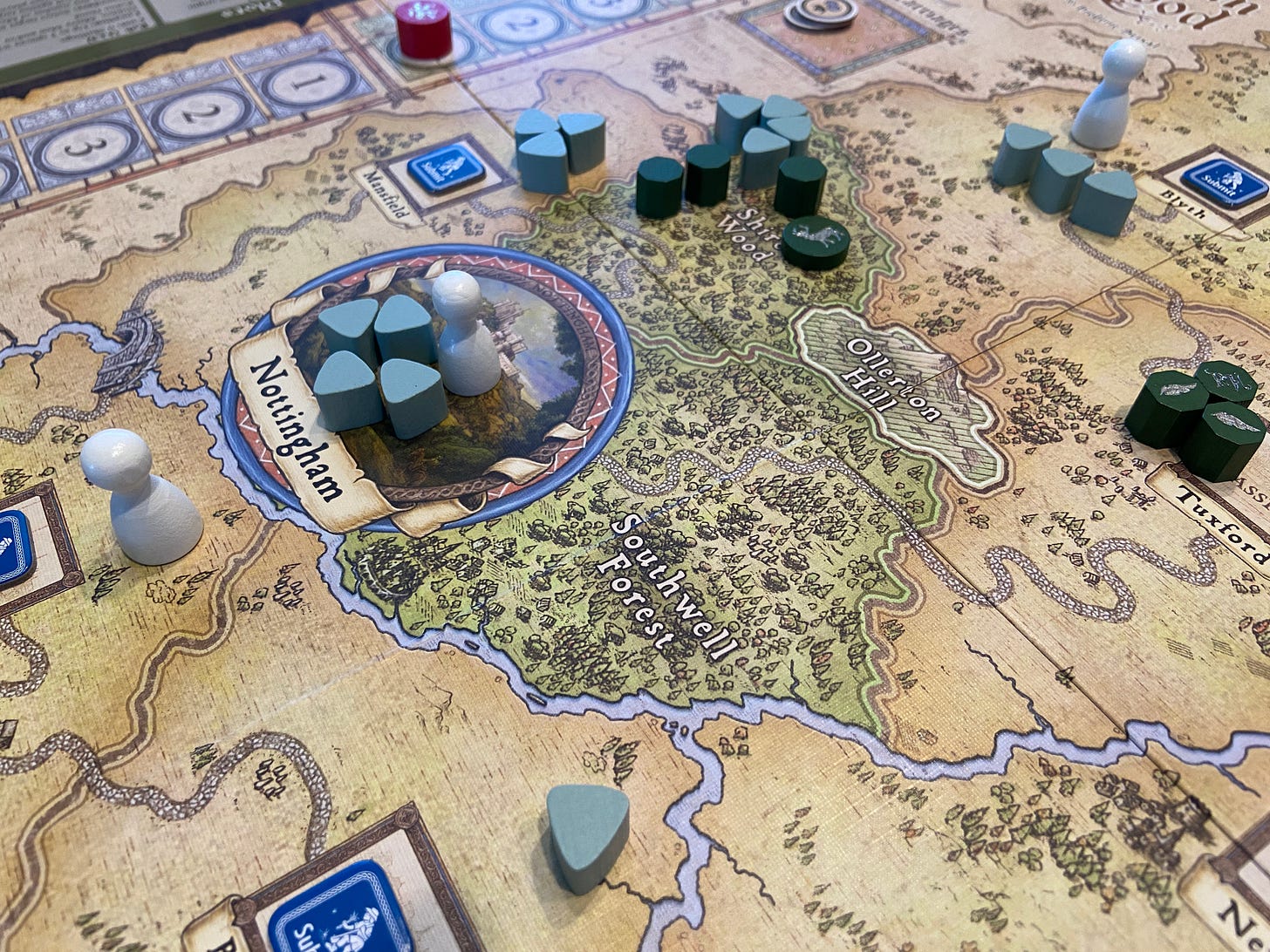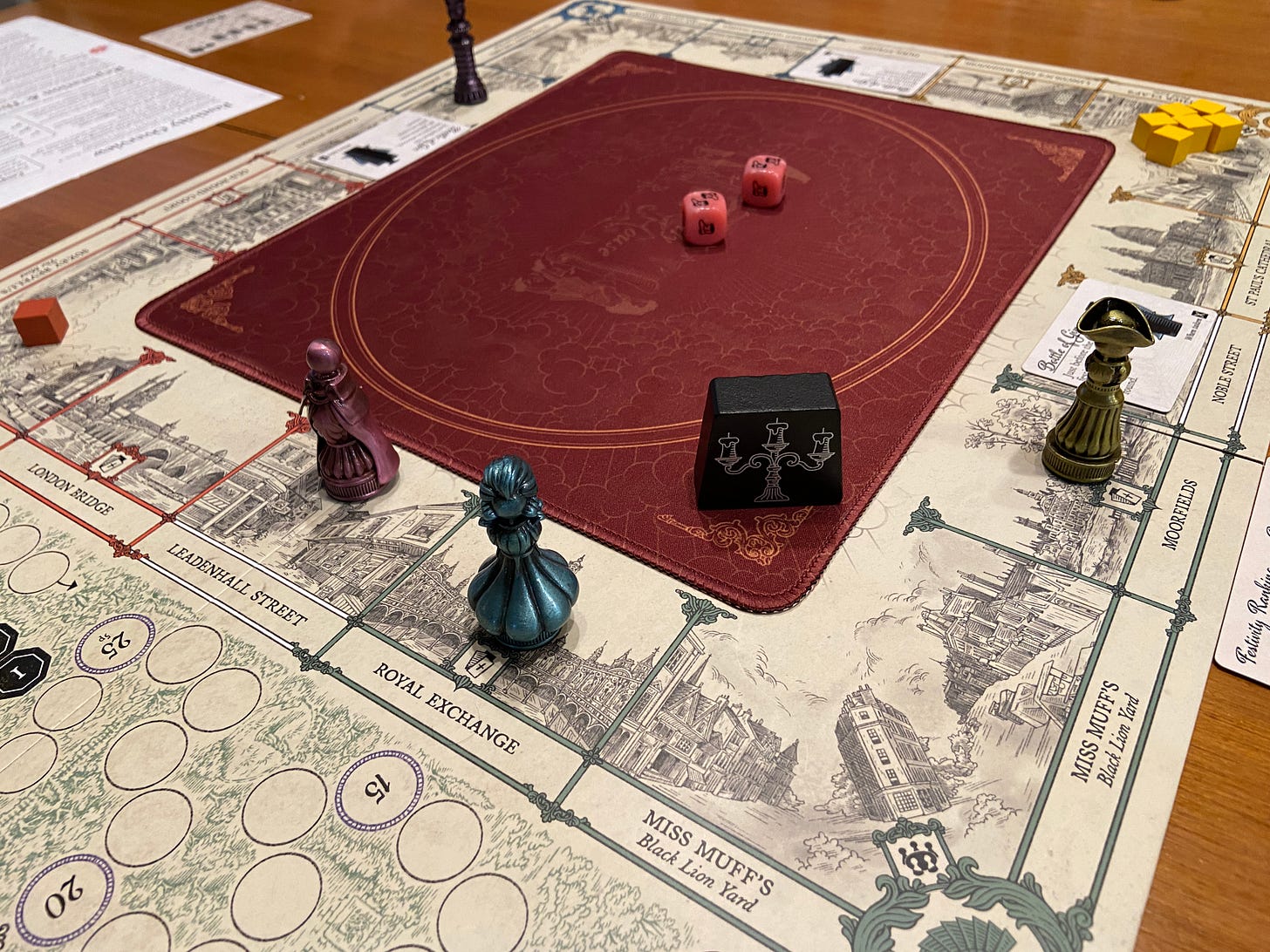Ascension Tactics: Inferno, Purple Haze, Shards of Infinity, Gest of Robin Hood
Week of April 28th, 2025
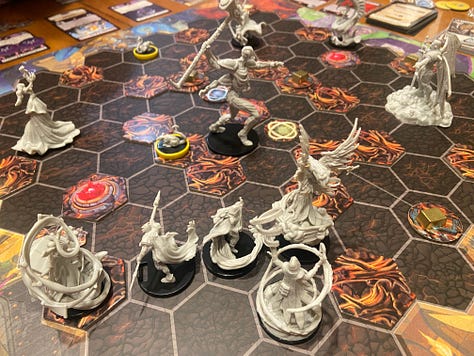
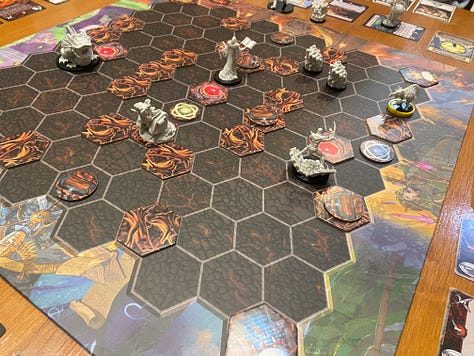
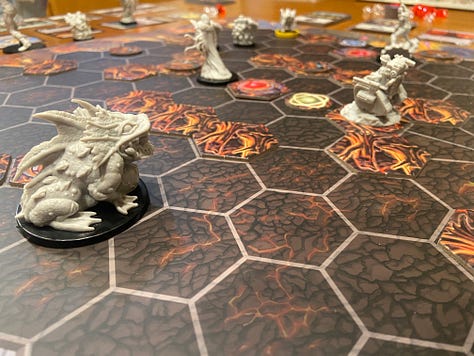
I’m on the record as a certified fan of the Ascension line of games, which has a ton of great products and spawned a legion of copycats over the 15 years it’s been around. Ascension Tactics itself first came out about three years ago and really surprised me by how good it was — I wasn’t quite sure if the deck-building / tactical-miniatures game combo was going to work — so I was onboard for the follow-up, Ascension Tactics: Inferno.
I realize I’ve never written formally about Ascension Tactics, so I’ll say a couple things here. I have to imagine everyone has some familiarity with either Ascension or one of its many knock-offs (Star/Hero/Cthulhu Realms, the Legendary games, the various Cryptozoic licensed deckbuilders, and Star Wars: The Deckbuilding Games, to pick the big ones). Like all these, Ascension gives you two currencies: card purchasing (Runes) and fighting (Power). Each card that passes through the center row requires spending one of these currencies to acquire or defeat (or sometimes, in War of the Shadows, both!). The way Tactics works is that it’s taken the Power currency and divorced it from the center row (essentially), so instead of spending it in the same way as Runes but to defeat monsters and earn bonuses, you have a whole new tactical game which has now become the core activity. You use Power to activate champions to move and attack. Straightforward enough, but as with all things Ascension, the real game is in how well all this has been balanced and integrated. The economy of the center row has been entirely rebuilt around driving a tactical game. Champions show up in a dizzying variety which plays off of the new card deck. It all works together seamlessly to produce a ton of range. Plus, and I think this is a big deal, it gives you a bunch of different play modes (duel, brawl, team, boss, cooperative, campaign), all of which are actually good. Clearly the duel is the focus and probably the best bit, but I’ve played all the modes and they’re all fun, with only team being a little finicky — the Champion draft at the start of the game can become high-stakes.
To follow on from that, I think the one thing to note for fans of traditional deck-builders tackling Ascension Tactics is that there is more up-front complexity. You’ll be drafting a team of four or so Champions to start (although new players will want to use the suggested teams for a while). That draft matters. In classic Ascension everyone starts at the same place and you slowly build out your deck, trying to retain optionality until you can jump one way or the other. Here that initial Champion draft will drive your deck-building, and a team without a nice balance of range and synergy of capabilities may be a problem. It’s not too difficult to build good teams, but you do have to be mindful as it’s possible to put yourself in a hole before you’ve really started.
Ascension Tactics had a lot of range as a game but still used mostly fairly straightforward effects. Inferno is definitely more gonzo, with more intricate combos, bigger turns, and a higher power ceiling. If you wanted to get into the game I wouldn’t start with it, but since I had played quite a lot of Tactics I was immediately totally engaged and loved all the new stuff. You’ve got Quests and Devour Soul tokens to give your Champions game-long enhancements. Champions can Transform. There is a whole new faction, Fallen, which brings in Champions, Heroes, and Constructs with a new more aggressive flavor. The Cultist has been fleshed out into a whole new Minion class of champions which is associated with the Fallen faction and more well-developed. It’s all super-fun and leads to games that can be even more fast-paced and can have a little bit more of a narrative feel as everything feels higher-ceiling and it’s not just your deck, but your Champions that can evolve and grow.
There are a few things to be careful of. Because of the high ceiling, I do think it’ll be more prone to blowouts and less accessible to players of differing experience. So again, don’t start here. Also, in the classic Ascension card game, different sets don’t always play together nicely. The game tended to have cycles, where pairs of adjacent sets (Storm of Souls and Immortal Heroes, Delirium and Deliverance, Unravelled and Dawn of Champions, Skull & Sails and Curse of the Golden Isles) might play together nicely thematically and mechanically and so you could mix them without issues, but if you mixed random sets it would’t work that well (or even at all). Mixing two great standalones, War of the Shadows and Dreamscape, would be totally incoherent. I’m not sure how well Inferno will mix with the original Tactics. The set feels built around the new mechanics (Quests, Minions, Devour Soul) in a way that might not be great to dilute. I haven’t tried to do it, so I don’t know for sure, but my strong instinct is you’ll want to play one or the other.
I really enjoyed this and it gets a strong recommend from me. Engaging, lots of tactical nuance, a ton of range. I also quite enjoy the world-building, which while it’s mostly through visual design, is still really strong. I got on this Kickstarter because of how much I had enjoyed the original, but as always it’s never clear if expansions or variations can continue to deliver. But in this case I think it does.
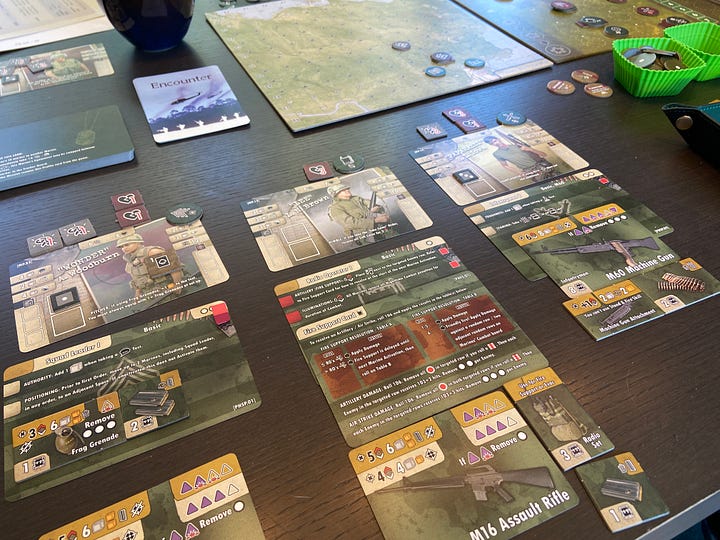

We finally continued our long-delayed Purple Haze campaign. I continue to find it very engaging, even though there are a few things that I’m not sure how to feel about.
The big issue is that like many Phalanx games, it’s just overly complicated and unwieldy. This is not a game that can come off the shelf occasionally — you have to be committed. And even then it’s hard to play error-free games. As a solo/co-op game the cost of getting rules wrong isn’t terrible, but it’s not great either.
I’m still trying to figure out how to think about some elements of the game. For me, its desire to be historically evocative sometimes clashes with its desire to be a roleplaying game, and that roleplaying instinct clashes with the actuality of it being a boardgame. One particular example struck me this time. One of the things I like about Up Front is that it makes the battlefield appropriately dangerous. If Watson breaks cover at long range to make a dash for a building he’ll probably make it, but if that MG34 happens to pull a black 6 he just gets killed. Purple Haze uses a “hit point” model, so when you walk into a VC ambush your soldiers will get blasted and lose a lot of hit points, but until they cross their wound threshold they won’t get injured, and they won’t get killed until they cross their wound threshold twice. This bothers me in a game that makes as much effort at verisimilitude as Purple Haze does. Hit points are a mechanic that has existed since time immemorial and works for gaming purposes — nothing strikes fear into a gamer like being low on hit points — but really makes no sense as a model of a reality that involves military-grade firearms, and it does not give give you the sense of danger, dread, and, crucially, capriciousness of combat.
Its choice to focus on the US Marine Corps is also interesting and I’m not sure it was right. The USMC contributed a relatively small number of soldiers to Vietnam (roughly two divisions, while the Army had 7 plus a number of smaller non-divisional units). Crucially, the Marines in frontline combat roles were overwhelmingly volunteers while the Army was predominantly draftees. While about 70% of total Army personnel was volunteers, this masks the fact that they were much more likely to be put into non-combat roles, with 50-60% of frontline soldiers being draftees. I’ve said this before but one of the reasons I like Up Front and Squad Leader is that their focus is on the most common experience of the war, the draftees and line units. The popular memory of Vietnam, at least in the US, is dominated by the draft and its many grievous injustices that put the weight of the war mostly on lower socio-economic classes and minorities while elites could hide in the many exemptions crafted for them: famously the national guard and student and hardship deferments. By presenting itself as an Everyman view of the war, but focusing on the Marines, Purple Haze elides an extremely culturally important aspect. Is this really important? I don’t know. But for me, I think it would have been better to focus on a regular army unit.
The Vietnam War is a heinously complicated topic, situated as it is at the brutal nexus of colonialism, racism, nationalism, religion, class divides, incompetence, and large-scale war crimes. There is a reason that it’s the US’ most traumatic war and reverberates in politics through to the present day. Still, I think Purple Haze is a good game. I’ve enjoyed it. Like U-Boot before it, it’s probably not for anyone who doesn’t have a strong interest in the topic. But for those who know enough to contextualize it and are comfortable both with the complexity, commitment, and moral ambiguity, I think it’s worth checking out.
The Shards of Infinity: Saga Collection is the recent reissue of all the existing Shards of Infinity content, plus a whole bunch of new promos (for Kickstarter backers). I always quite enjoyed Shards, but after playing the original 2018 core set a bunch I eventually let it drop. I wasn’t playing a ton of two-player euros back then and so didn’t really have a constituency for it. Post-pandemic I’m playing more 2-player games, the Saga edition had a lot more stuff in it, I did remember it as a really good game, and the Stoneblade folks know what they’re doing, so I decided to give it a try.
Shards of Infinity is clearly the Ascension designers’ answer to the Realms games: Ascension remade into a dueling format where you’re trying to reduce your opponent’s health to zero. It’s just a cleaner, tighter, and wider-ranging version of Star Realms and its many spin/knock-offs (including Star Wars: The Deckbuilding Game). You’ve got the same 4-faction structure but the factions are more coherent thematically and mechanically. The new idea is Mastery, a kind of “leveling” counter which increases the power of many cards and when you get to 30 it turns one of your cards into an “I win” card. The main thing that it shares with Ascension (and Race for the Galaxy, Blue Moon, Spirit Island, Mistborn, and others) and which makes it difficult to talk about is that the value here is the incredible attention to detail in balancing the cards and game systems. No more Realms-style interminable games as one player specializes in health recovery or blocking cards; Shards will wrap in 20 minutes or so like a sensible card game.
Like Ascension Tactics, Shards of Infinity includes a bunch of different play modes, including duel, team, free-for-all, solo, and cooperative campaign. I’ve only played duel and solo; duel is obviously the focus and while solo is fine you’d probably play Unstoppable first. The team rules are pretty much identical to Ascension’s and are probably solid; generally if you want to play Ascension with 4, I’d recommend the strong 2 vs 2 game over the good but downtime-prone straight 4-player. Where things get a little interesting is in the free-for-all. The default rules are that you just punch whoever you want. However, we now have a much better solution to this problem in Mistborn’s (via King of Tokyo) target rules, and I wonder if just importing those wholesale would dramatically improve the multiplayer experience. Normally I wouldn’t be that tempted by the straight 4-player game, but I kinda want to try that idea now!
I think the other big thing I like about Shards as a total design is that, like Ascension, the worldbuilding is pretty good. These games are all part of the Magic: The Gathering family tree so they’re never going to be super-deep thematically, but like in Unstoppable or Ascension the fictional world does click and feel present in a way it doesn’t in Star Realms or even Star Wars: the Deckbuilding Game (which, to be clear, is fine but relies pretty heavily on the fact that you already know and love Star Wars). It’s not a small thing.
The new Saga edition combines all the previous Shards of Infinity content. This is nice because the way content dribbled out over the game’s life wasn’t ideal. The original base set was small and had a somewhat limited range, and the expansions were incremental. The large set gives you a feeling of completeness (as one would hope I suppose!).
The reprint of A Gest of Robin Hood was available when we were at the GMT Warehouse and a friend picked it up. Its terrific physical presentation and short playing time convinced me to try it. And, this will probably shock you as much as it did me, I rather enjoyed it! I know! Let’s not get carried away, there are some major caveats which I’ll get to, but still. Why did this basically work for me where so, so many COIN & ICS games have abjectly failed?
I think the fact that it’s not making a serious attempt at real history, and just trying to evoke the legend, is a big plus. It can be heightened and adventure-y and we don’t have to worry about whose story the game is telling, or whether the game is being fair to the Sheriff of Nottingham, or what war crimes it’s sweeping under the rug. There is no terrorism. There is definitely some extortion, but the game is surprisingly transparent about what’s going on there: you draw a traveller card and after you see who it is you decide whether to beat them up or whatever. It definitely makes the game feel less bloodless than the usual COIN “select extortion and take $1” actions. The fact that the actions are all pretty straightforward with only a little branching logic and minimal preconditions or mandatory sequencing makes it so much easier to manage; the various intricate pacification sequences in the other games drive me nuts and kill games and are not very interesting. I like that there is now some hidden information. The economy for the Sheriff is primarily in oppressing the locals by extracting taxes and then carrying around the cash in carts which Robin Hood has to try to intercept and loot, but what exactly is in each cart is secret and the Merry Men can get burned by hidden guards. Robin Hood’s economy of stealing people’s stuff is built around risk, which is nice — you roll dice and when you’re going after travelers you can generally take a safer or a high-risk but high-reward option. Plus of course it’s a beautiful physical product. All this gives the game a much more evocative texture.
This is COIN, so of course I have concerns. Multiple concerns. One is that Robin Hood has gotten totally steamrolled all the times I’ve played. The Sheriff’s game is not rocket science, keep your taxation economy going and the people oppressed and run the Merry Men to the ground (fortunately the last two overlap almost completely). Robin Hood has to dodge and weave (he has no significant ability to attack the Sheriff’s henchmen), raiding and redistributing wealth and trying to make Nottingham ungovernable. You have to be super-wily, and your position seems quite fragile. I’ve heard from a number of people that Robin Hood is definitely harder to play and with a little experience things should even out, but still, an initial balance impression like this isn’t great. However, there is more. Being a short game (60-90min) with a low piece density and basically no randomness in the Sheriff’s operations, it seems like it’s going to be quite unforgiving. Robin Hood has to get some kind of economy going quickly, both in terms of cash and ability to recruit, and that reminds me a lot of Star Wars: Rebellion. Like the Empire in that game, it feels like he has a very interesting balancing act to manage while the opponent does pretty straightforward things. So it’s possible the game is decided far more by Robin Hood’s play than by the Sheriff’s. Also, like In the Shadows, we’re talking a short game with strong events where the timing of when those events land can be very impactful.
So there are plenty of reasons to be skeptical still. If I had to bet money, I would bet on it quickly burning out for me. It’s obviously no Watergate or Ascension Tactics or Wir Sind das Volk. Still, my first three games were engaging and where other two-player attempts at a COIN game (Colonial Twilight, The British Way, In the Shadows) crashed pretty hard for me for a wide range of reasons, at this point I’ll totally play Gest of Robin Hood again. Perhaps it’s just I’m feeling compelled to work out the strategy for Robin Hood? But I think it’s more than just that. Plus, it’s on BGA now so you can give it a try without killing any trees or paying any tariffs.
Molly House — still awesome. The rules have been surprisingly troublesome to get 100% nailed down. Fortunately the last couple things were minor and didn’t affect the overall feel or balance much, but the game works better if you do everything correctly. I’m now in a position (after 5 games or so) where I can easily and cleanly teach it. I’ve become a bit skeptical of the nice metal pawns; the color match isn’t great and two of them (yellow and green) are too close together. The wooden pawns are probably better in general and I’ll probably switch to using those for reasons of practicality. Anyway, I’m still enjoying the heck out of this and every game has been colorful, engaging, and evocative.
Coda
The time period of Molly House corresponds to the beginning of the emergence of the clarinet as a full-fledged member of the orchestra. Even in the 18th century dates and attributions for musicians and works is sketchy; Beethoven’s famous duos for clarinet and bassoon are virtually certainly not by Beethoven and both Devienne and Mozart have other’s work attributed to them. If you own a publishing company and you need a new boat and some rando has just sold you a score, it will sell better if you put a well-known name on it instead. So anyway, we don’t have a better date than 1750-ish for Johann Stamitz’ (Jan Václav Antonín Stamic) clarinet concerto, and actually we’re not even totally sure if he or his son Carl wrote it. The clarinet it would have been played on (probably) was quite primitive, just a couple keys, limited chromatic capabilities, limited range, and probably very sketchy intonation. The concerto isn’t super-interesting by today’s standards. But it is the first that we still know of, and the clarinet’s evolution from a relatively primitive instrument would take place over the next 40 years — culminating with Mozart’s clarinet concerto and then Beethoven adding it to the standard orchestral lineup. No instrument has been added as standard since, although often not for particularly good reasons. As you might guess.
That’s it! See you next week!




